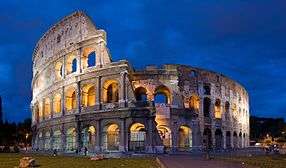Roman technology
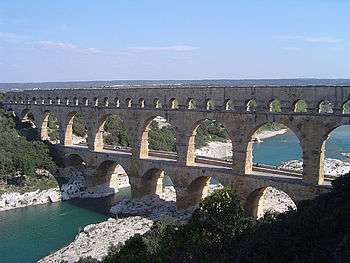
Roman technology is the engineering practice which supported Roman civilization and made the expansion of Roman commerce and Roman military possible for over a millennium (753 BC–476 AD).
The Roman Empire was one of the most technologically advanced civilizations of antiquity, with some of the more advanced concepts and inventions forgotten during the turbulent eras of Late Antiquity and the early Middle Ages. Gradually, some of the technological feats of the Romans were rediscovered and/or improved upon, while others went ahead of what the Romans had done during the Middle Ages and the beginning of the Modern Era. Several Roman technological feats in different areas like civil engineering, construction materials, transport technology, and some inventions such as the mechanical reaper, were surprising achievements until the 19th century. The Romans achieved high levels of technology in large part because they borrowed technologies and absorbed the cultures of pre-existing (Hellenic peoples of the Mediterranean basin and the Celts of Gaul.
The energy constraint


All technology uses energy to transform the material into a desirable object or uses some form of mechanics combined with another form to make something better. The cheaper energy is, the wider the class of technologies that are considered economic. This is why technological history can be seen as a succession of ages defined by energy type i.e. human, animal, water, peat, coal, and oil.[3] The Romans used water power, and watermills were common throughout the Empire, especially to the end of the 1st century AD. They were used for cereals milling, sawing timber and crushing ore. They exploited wood and coal for heating. There were huge reserves of wood, peat and coal in the Roman Empire, but they were all in the wrong place. Wood could be floated down rivers to the major urban centres but otherwise it was a very poor fuel, being heavy for its caloric value. If this was improved by being processed into charcoal, it was bulky. Nor was wood ever available in any concentration. Diocletian's Price Edict can give us a glimpse of the economics of transporting wood. The maximum price of a wagon load of 1,200 lbs of wood was 150 d.(denari). The maximum freight charge per mile for the same wagon load was 20 d. per mile. Room heating was normally better done by charcoal braziers than hypocausts. But hypocausts did allow them to exploit any poor-quality smoky fuels like straw, vine prunings and small wood locally available. Hypocausts also allowed them to generate a humid heat for their baths.
The Romans worked almost all the coalfields of England that outcropped on the surface, by the end of the 2nd century (Smith 1997; 323). But there is no evidence that this exploitation was on any scale. After c. 200 AD the commercial heart of the Empire was in Africa and the East where the climate severely limited timber growth. There was no large coalfield on the edge of the Mediterranean.
Nevertheless, in Roman Egypt all the essential components of the much later steam engine were first assembled by the Greek Mathematician and Engineer Hero:
With the crank and connecting rod system, all elements for constructing a steam engine (invented in 1712) — Hero's aeolipile (generating steam power), the cylinder and piston (in metal force pumps), non-return valves (in water pumps), gearing (in water mills and clocks) — were known in Roman times.[4]
However, the aeolipile was a reaction engine, inefficient as a stationary engine. The first useful steam engine did not use steam pressure at all, but followed up a scientific advance in understanding air pressure.
Craft basis


Roman technology was largely based on a system of crafts, although the term engineering is used today to describe the technical feats of the Romans. The Greek words used were mechanic or machine-maker or even mathematician which had a much wider meaning than now. There were a large number of engineers employed by the army. The most famous engineer of this period was the Greek Apollodorus of Damascus. Normally each trade, each group of artisans—stonemasons, glass blowers, surveyors, etc.—within a project had its own practice of masters and apprentices, and many tried to keep their trade secrets, passing them on solely by word of mouth, a system still in use today by those who do not want to patent their inventions. Writers such as Vitruvius, Pliny the Elder and Frontinus published widely on many different technologies, and there was a corpus of manuals on basic mathematics and science such as the many books by Archimedes, Ctesibius, Heron (a.k.a. Hero of Alexandria), Euclid and so on. Not all of the manuals which were available to the Romans have survived, as lost works illustrate.
Much of what is known of Roman technology comes indirectly from archaeology and from the third-hand accounts of Latin texts copied from Arabic texts, which were in turn copied from the Greek texts of scholars such as Hero of Alexandria or contemporary travellers who had observed Roman technologies in action. Writers like Pliny the Elder and Strabo had enough intellectual curiosity to make note of the inventions they saw during their travels, although their typically brief descriptions often arouse discussion as to their precise meaning. On the other hand, Pliny is perfectly clear when describing gold mining, his text in book XXXIII having been confirmed by archaeology and field-work at such sites as Las Medulas and Dolaucothi.
Engineering and construction
The Romans made great use of aqueducts, dams, bridges, and amphitheatres. They were also responsible for many innovations to roads, sanitation, and construction in general. Roman architecture in general was greatly influenced by the Greeks and Etruscans. Many of the columns and arches seen in Roman architecture were adopted from the Greek and Etruscan civilizations present in Italy.
In the Roman Empire, cements made from pozzolanic ash/pozzolana and an aggregate made from pumice were used to make a concrete very similar to modern Portland cement concrete. In 20s BC the architect Vitruvius described a low-water-content method for mixing concrete. The Romans found out that insulated glazing (or "double glazing") improved greatly on keeping buildings warm, and this technique was used in the construction of public baths.
Another truly original process which was born in the empire was the practice of glassblowing, which started in Syria and spread in about one generation in the empire.
There were many types of presses to press olives. In the 1st century AD, Pliny the Elder reported the invention and subsequent general use of the new and more compact screw presses. However, the screw press was almost certainly not a Roman invention. It was first described by the Greek mathematician and engineer, Hero of Alexandria, but may have already been in use when he mentioned it in his Mechanica III.
Cranes were used for construction work and possibly to load and unload ships at their ports, although for the latter use there is according to the “present state of knowledge” still no evidence.[5] Most cranes were capable of lifting about 6–7 tons of cargo, and according to a relief shown on Trajan's column were worked by treadwheel.
Roads
The Romans primarily built roads for their military. Their economic importance was probably also significant, although wagon traffic was often banned from the roads to preserve their military value. At its largest extent the total length of the Roman road network was 85,000 kilometres (53,000 mi).
Way stations providing refreshments were maintained by the government at regular intervals along the roads. A separate system of changing stations for official and private couriers was also maintained. This allowed a dispatch to travel a maximum of 800 kilometres (500 mi) in 24 hours by using a relay of horses.
The roads were constructed by digging a pit along the length of the intended course, often to bedrock. The pit was first filled with rocks, gravel or sand and then a layer of concrete. Finally they were paved with polygonal rock slabs. Roman roads are considered the most advanced roads built until the early 19th century. Bridges were constructed over waterways. The roads were resistant to floods and other environmental hazards. After the fall of the Roman Empire the roads were still usable and used for more than 1000 years.
Most Roman cities were shaped like a square. There were 4 main roads leading the center of the city, or forum. They formed a cross shape, and each point on the edge of the cross was a gateway into the city. Connecting to these main roads were smaller roads, the streets where people lived.
Aqueducts
The Romans constructed numerous aqueducts to supply water. The city of Rome itself was supplied by eleven aqueducts made of limestone that provided the city with over 1 million cubic metres of water each day, sufficient for 3.5 million people even in modern-day times,[6] and with a combined length of 350 kilometres (220 mi).[7] Water inside the aqueducts depended entirely on gravity. The raised stone channels in which the water travelled were slightly slanted. The water was carried directly from mountain springs. After it had gone through the aqueduct, the water was collected in tanks and fed through pipes to fountains, toilets, etc.[8] The main aqueducts in Ancient Rome were the Aqua Claudia and the Aqua Marcia.[9] Most aqueducts were constructed below the surface with only small portions above ground supported by arches.[10] The longest Roman aqueduct, 178 kilometres (111 mi) in length, was traditionally assumed to be that which supplied the city of Carthage. The complex system built to supply Constantinople had its most distant supply drawn from over 120 km away along a sinuous route of more than 336 km.[11]
Roman aqueducts were built to remarkably fine tolerances, and to a technological standard that was not to be equalled until modern times. Powered entirely by gravity, they transported very large amounts of water very efficiently. Sometimes, where depressions deeper than 50 metres had to be crossed, inverted siphons were used to force water uphill.[10] An aqueduct also supplied water for the overshot wheels at Barbegal in Roman Gaul, a complex of water mills hailed as "the greatest known concentration of mechanical power in the ancient world".[1]
Bridges
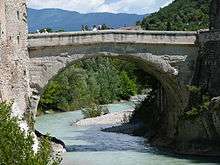
Roman bridges were among the first large and lasting bridges built. They were built with stone and/or concrete and utilized the arch. Built in 142 BC, the Pons Aemilius, later named Ponte Rotto (broken bridge) is the oldest Roman stone bridge in Rome, Italy. The biggest Roman bridge was Trajan's bridge over the lower Danube, constructed by Apollodorus of Damascus, which remained for over a millennium the longest bridge to have been built both in terms of overall and span length. They were most of the time at least 60 feet (18 m) above the body of water.
An example of temporary military bridge construction is the two Caesar's Rhine bridges.
Dams
They also built many dams for water collection, such as the Subiaco Dams, two of which fed Anio Novus, one of the largest aqueducts of Rome. They built 72 dams in just one country, Spain and many more are known across the Empire, some of which are still in use. At one site, Montefurado in Galicia, they appear to have built a dam across the river Sil to expose alluvial gold deposits in the bed of the river. The site is near the spectacular Roman gold mine of Las Medulas. Several earthen dams are known from Britain, including a well-preserved example from Roman Lanchester, Longovicium, where it may have been used in industrial-scale smithing or smelting, judging by the piles of slag found at this site in northern England. Tanks for holding water are also common along aqueduct systems, and numerous examples are known from just one site, the gold mines at Dolaucothi in west Wales. Masonry dams were common in North Africa for providing a reliable water supply from the wadis behind many settlements.
Mining

The Romans also made great use of aqueducts in their extensive mining operations across the empire, some sites such as Las Medulas in north-west Spain having at least 7 major channels entering the minehead. Other sites such as Dolaucothi in south Wales was fed by at least 5 leats, all leading to reservoirs and tanks or cisterns high above the present opencast. The water was used for hydraulic mining, where streams or waves of water are released onto the hillside, first to reveal any gold-bearing ore, and then to work the ore itself. Rock debris could be sluiced away by hushing, and the water also used to douse fires created to break down the hard rock and veins, a method known as fire-setting.
Alluvial gold deposits could be worked and the gold extracted without needing to crush the ore. Washing tables were fitted below the tanks to collect the gold-dust and any nuggets present. Vein gold needed crushing, and they probably used crushing or stamp mills worked by water-wheels to comminute the hard ore before washing. Large quantities of water were also needed in deep mining to remove waste debris and power primitive machines, as well as for washing the crushed ore. Pliny the Elder provides a detailed description of gold mining in book xxxiii of his Naturalis Historia, most of which has been confirmed by archaeology. That they used water mills on a large scale elsewhere is attested by the flour mills at Barbegal in southern France, and on the Janiculum in Rome.
Sanitation

The Romans did not invent plumbing or toilets, but instead borrowed their waste disposal system from their neighbors, particularly the Minoans.[12] A waste disposal system was not a new invention, but rather had been around since 3100 BCE, when one was created in the Indus River Valley [13] The Roman public baths, or thermae served hygienic, social and cultural functions. The baths contained three main facilities for bathing. After undressing in the apodyterium or changing room, Romans would proceed to the tepidarium or warm room. In the moderate dry heat of the tepidarium, some performed warm-up exercises and stretched while others oiled themselves or had slaves oil them. The tepidarium’s main purpose was to promote sweating to prepare for the next room, the caldarium or hot room. The caldarium, unlike the tepidarium, was extremely humid and hot. Temperatures in the caldarium could reach 40 degrees Celsius (104 degrees Fahrenheit). Many contained steam baths and a cold-water fountain known as the labrum. The last room was the frigidarium or cold room, which offered a cold bath for cooling off after the caldarium. The Romans also had flush toilets.
Roman military technology

The Roman military technology ranged from personal equipment and armament to deadly siege engines. They inherited almost all ancient weapons.
While heavy, intricate armour was not uncommon (cataphracts), the Romans perfected a relatively light, full torso armour made of segmented plates (lorica segmentata). This segmented armour provided good protection for vital areas, but did not cover as much of the body as lorica hamata or chainmail. The lorica segmentata provided better protection, but the plate bands were expensive and difficult to produce and difficult to repair in the field. Overall, chainmail was cheaper, easier to produce, and simpler to maintain, was one-size fits all, and was more comfortable to wear – thus, it remained the primary form of armour even when lorica segmentata was in use.
The Roman cavalry saddle had four horns and was believed to have been copied from Celtic peoples.
Roman siege engines such as ballistas, scorpions and onagers were not unique. But the Romans were probably the first people to put ballistas on carts for better mobility on campaigns. On the battlefield, it is thought that they were used to pick off enemy leaders. There is one account of the use of artillery in battle from Tacitus, Histories III,23:
- On engaging they drove back the enemy, only to be driven back themselves, for the Vitellians had concentrated their artillery on the raised road that they might have free and open ground from which to fire; their earlier shots had been scattered and had struck the trees without injuring the enemy. A ballista of enormous size belonging to the Fifteenth legion began to do great harm to the Flavians' line with the huge stones that it hurled; and it would have caused wide destruction if it had not been for the splendid bravery of two soldiers, who, taking some shields from the dead and so disguising themselves, cut the ropes and springs of the machine.
Technologies developed or invented by the Romans
| Technology | Comment | |
|---|---|---|
 Roman Pentaspastos ("Five-pulley-crane"), a medium-sized variant (c. 450 kg load)  Roman harvesting machine: overview  The unfinished Roman Corinth Canal, 1st century AD 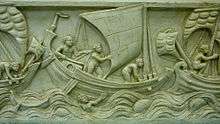 Ship with spritsail, the earliest fore-and-aft rig, 3rd century AD Pointable fire engine nozzle Late Roman paddle-wheel boat, 4th century AD (medieval copy) 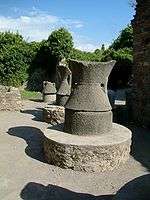 Donkey mills at Pompeii Oil press of Early (pre?) Roman type  Modern oil screw press following Roman conceptual innovation stern mounted rudder 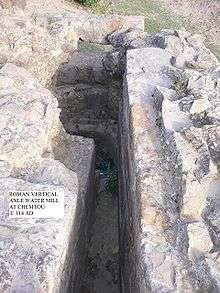 Roman turbine mill at Chemtou, Tunisia 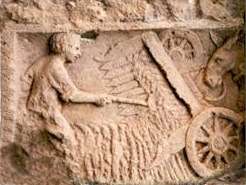 Roman harvesting machine: detail 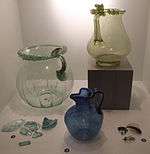 Glassware from Pompeii _-_n._11141_-_Museo_di_Napoli_-_Strumenti_di_chirurgia.jpg) Roman surgery tools  Roman crank handle from Augusta Raurica, dating to no later than c. 250 AD[14] |
Abacus, Roman | Portable. |
| Alum | The production of alum (KAl(SO4)2.12H2O) from alunite (KAl3(SO4)2.(OH)6) is archaeologically attested on the island Lesbos.[15] This site was abandoned in the 7th century but dates back at least to the 2nd century AD. | |
| Amphitheatre | See e.g. Colosseum. | |
| Aqueduct, true arch | Pont du Gard, Segovia etc. | |
| Arch, monumental | ||
| Bath, monumental public (Thermae) | See e.g. Baths of Diocletian | |
| Book (Codex) | First mentioned by Martial in the 1st century AD. Held many advantages over the scroll. | |
| Brass | The Romans had enough understanding of zinc to produce a brass denomination coinage; see sestertius. | |
| Bridge, true arch | See e.g. Roman bridge in Chaves or the Severan Bridge. | |
| Bridge, segmental arch | More than a dozen Roman bridges are known to feature segmental (=flat) arches. A prominent example was Trajan's bridge over the Danube, a lesser known the extant Limyra Bridge in Lycia | |
| Bridge, pointed arch | Constructed in the early Byzantine era, the earliest known bridge featuring a pointed arch is the 5th or 6th century AD Karamagara Bridge[16] | |
| Camel harness | The harnessing of camels to ploughs is attested in North Africa by the 3rd century AD[17] | |
| Cameos | Probably a Hellenistic innovation e.g. Cup of the Ptolemies but taken up by the Emperors e.g. Gemma Augustea, Gemma Claudia etc. | |
| Cast Iron | Recently archaeologically detected in the Val Gabbia in northern Lombardy from the 5th and 6th centuries AD.[18] This technically interesting innovation appears to have had little economic impact. But archaeologists may have failed to recognize the distinctive slag, so the date and location of this innovation may be revised. | |
| Cement | Pozzolana variety | |
| Crank handle | A Roman iron crank handle was excavated in Augusta Raurica, Switzerland. The 82.5 cm long piece with a 15 cm long handle is of yet unknown purpose and dates to no later than c. 250 AD.[14] | |
| Crank and connecting rod | Found in several water-powered saw mills dating from the late 3rd (Hierapolis sawmill) to 6th century AD (at Ephesus respectively Gerasa).[2] | |
| Crane, treadwheel | ||
| Dam, Arch[19] | Currently best attested for the dam at Glanum, France dated c. 20 BC.[20] The structure has entirely disappeared. Its existence attested from the cuts into the rock on either side to key in the dam wall, which was 14.7 metres high, 3.9m thick at base narrowing to 2.96m at the top. Earliest description of arch action in such types of dam by Procopius around 560 AD, the Dara Dam[21] | |
| Dam, Arch-gravity | Examples include curved dams at Orükaya,[22] Çavdarhisar, both Turkey (and 2nd century)[22]Kasserine Dam in Tunisia,[23] and Puy Foradado Dam in Spain (2nd–3rd century)[24] | |
| Dam, Bridge | The Band-i-Kaisar, constructed by Roman prisoners of war in Shustar, Persia, in the 3rd century AD,[25] featured a weir combined with an arch bridge, a multifunctional hydraulic structure which subsequently spread throughout Iran.[26] | |
| Dam, Buttress | Attested in a number of Roman dams in Spain,[24] like the 600 m long Consuegra Dam | |
| Dam, Multiple Arch Buttress | Esparragalejo Dam, Spain (1st century AD) earliest known[27] | |
| Dome, monumental | See e.g. Pantheon. | |
| Foot-powered loom | Before 298 AD, with a hint the invention arose at Tarsus[28] | |
| Flos Salis | A product of salt evaporation ponds Dunaliella salina[29] used in the perfume industry (Pliny Nat. Hist. 31,90) | |
| Force pump used in fire engine | See image of pointable nozzle | |
| Glass blowing | This led to a number of innovations in the use of glass. Window glass is attested at Pompeii in AD 79. In the 2nd century AD[30] hanging glass oil lamps were introduced. These used floating wicks and by reducing self-shading gave more lumens in a downwards direction. Cage cups (see photograph) are hypothesised as oil lamps. | |
| Dichroic glass as in the Lycurgus Cup. Note, this material attests otherwise unknown chemistry (or other way?) to generate nano-scale gold-silver particles. | ||
| Glass mirrors (Pliny the Elder Naturalis Historia 33,130) | ||
| Greenhouse cold frames | (Pliny the Elder Naturalis Historia 19.64; Columella on Ag. 11.3.52) | |
| Hydraulis | A water organ. Later also the pneumatic organ. | |
| Hushing | Described by Pliny the Elder and confirmed at Dolaucothi and Las Médulas | |
| Hydraulic mining | Described by Pliny the Elder and confirmed at Dolaucothi and Las Médulas | |
| Hydrometer | Mentioned in a letter of Synesius | |
| Hypocaust | A floor and also wall heating system. Described by Vitruvius | |
| Knife, multifunctional | ||
| Lighthouses | The best surviving examples are those at Dover castle and the Tower of Hercules at La Coruna | |
| Leather, Tanned | The preservation of skins with vegetable tannins was a pre-Roman invention but not of the antiquity once supposed. (Tawing was far more ancient.) The Romans were responsible for spreading this technology into areas where it was previously unknown such as Britain and Qasr Ibrim on the Nile. In both places this technology was lost when the Romans withdrew.[31] | |
| Mills | M.J.T.Lewis presents good evidence that water powered vertical pounding machines came in by the middle of the 1st century AD for fulling, grain hulling (Pliny Nat. Hist. 18,97) and ore crushing (archaeological evidence at Dolaucothi Gold Mines and Spain). | |
| Grainmill, rotary. According to Moritz (p57) rotary grainmills were not known to the ancient Greeks but date from before 160 BC. Unlike reciprocating mills, rotary mills could be easily adapted to animal or water power. Lewis (1997) argues that the rotary grainmill dates to the 5th century BC in the western Mediterranean. Animal and water powered rotary mills came in the 3rd century BC. | ||
| Sawmill, water powered. Recorded by 370 AD. Attested in Ausonius's poem Mosella. Translated "the Ruwer sends mill-stones swiftly round to grind the corn, And drives shrill saw-blades through smooth marble blocks". Recent archaeological evidence from Phrygia, Anatolia, now pushes back the date to the 3rd century AD and confirms the use of a crank in the sawmill.[32] | ||
| Shipmill, (Though small, the conventional term is "shipmill" not boat mill, probably because there was always a deck, and usually an enclosed superstructure, to keep the flour away from the damp.) where water wheels were attached to boats, was first recorded at Rome in 547 AD in Procopius of Caesarea's Gothic Wars (1.19.8–29) when Belisaurius was besieged there. | ||
| Essentials of the Steam engine | By the late 3rd century AD, all essential elements for constructing a steam engine were known by Roman engineers: steam power (in Hero's aeolipile), the crank and connecting rod mechanism (in the Hierapolis sawmill), the cylinder and piston (in metal force pumps), non-return valves (in water pumps) and gearing (in water mills and clocks)[4] | |
| Watermill. Improvements upon earlier models. For the largest mill complex known see Barbegal | ||
| Mercury Gilding | as in the Horses of San Marco | |
| Newspaper, rudimentary | See Acta Diurna. | |
| Odometer | ||
| Paddle wheel boats | In de Rebus Bellicis (possibly only a paper invention). | |
| Pewter | Mentioned by Pliny the Elder (Naturalis Historia34,160-1). Surviving examples are mainly Romano-British of the 3rd and 4th centuries e.g. and . Roman pewter had a wide range of proportions of tin but proportions of 50%, 75% and 95% predominate (Beagrie 1989). | |
| Pleasure lake | An artificial reservoir, highly unusual in that it was meant for recreational rather than utilitarian purposes was created at Subiaco, Italy, for emperor Nero (54–68 AD). The dam remained the highest in the Roman Empire (50 m),[33] and in the world until its destruction in 1305.[34] | |
| Plough | ||
| iron-bladed (A much older innovation (e.g. Bible; I Samuel 13,20-1) that became much more common in the Roman period) | ||
| wheeled (Pliny the Elder Naturalis Historia 18.171-3) (More important for the Middle Ages, than this era.) | ||
| Pottery, glossed | i.e. Samian ware | |
| Reaper | An early harvesting machine: vallus (Pliny the Elder Naturalis Historia 18,296, Palladius 7.2.2–4 ) | |
| Sails, fore-and-aft rig | Introduction of fore-and-aft rigs 1) the Lateen sail 2) the Spritsail, this last already attested in 2nd century BC in the northern Aegean Sea[35] Note: there is no evidence of any combination of fore-and-aft rigs with square sails on the same Roman ship. | |
| Sails, Lateen | Representations show lateen sails in the Mediterranean as early as the 2nd century AD. Both the quadrilateral and the triangular type were employed.[36][37][38][39][40][41][42][43][44][45] | |
| Roller Bearings | Archaeologically attested in the Lake Nemi ships[46] | |
| Rudder, stern-mounted | See image for something very close to being a sternpost rudder | |
| Sausage, fermented dry (probably) | See salami. | |
| Screw press | An innovation of about the mid-1st century AD[47] | |
| Sewers | See for example Cloaca Maxima | |
| Soap, hard (sodium) | First mentioned by Galen (earlier, potassium, soap being Celtic). | |
| Spiral staircase | Though first attested as early as the 5th century BC in Greek Selinunte, spiral staircases only become more widespread after their adoption in Trajan's column and the Column of Marcus Aurelius. | |
| Stenography, a system of | See Tironian notes. | |
| Street map, early | See Forma Urbis Romae (Severan Marble Plan), a carved marble ground plan of every architectural feature in ancient Rome.[48] | |
| Sundial, portable | See Theodosius of Bithynia | |
| Surgical instruments, various | ||
| Tooth implants, iron | See | |
| Towpath | e.g. beside the Danube, see the "road" in Trajan's bridge | |
| Tunnels | Excavated from both ends simultaneously. The longest known is the 5.6-kilometre (3.5 mi) drain of the Fucine lake | |
| Vehicles, one wheeled | Solely attested by a Latin word in 4th century AD Scriptores Historiae Augustae Heliogabalus 29. As this is fiction, the evidence dates to its time of writing. | |
| Wood veneer | Pliny Nat. Hist. 16.231-2 |
See also
Overview
- Roman architecture
- Roman aqueducts
- Roman engineering
- Roman metallurgy
- Roman mining
- Maritime hydraulics in antiquity
Selected works and writers
Other lists
- Ancient Greek technology
- History of science in Classical Antiquity
- Medieval technology
- Science in Medieval Western Europe
- List of Byzantine inventions
- Renaissance technology
References
- 1 2 Greene 2000, p. 39
- 1 2 Ritti, Grewe & Kessener 2007, p. 161; Grewe 2009, pp. 429–454
- ↑ For a discussion on the importance of energy sources as a constraint on all pre-industrial economies see E.A.Wrigley 2002 'The Quest for the Industrial Revolution' Proceedings of the British Academy 121 , 147–170 available free online, enter '2002 lecture' in search at /
- 1 2 Ritti, Grewe & Kessener 2007, p. 156, fn. 74
- ↑ Michael Matheus: "Mittelalterliche Hafenkräne," in: Uta Lindgren (ed.): Europäische Technik im Mittelalter. 800–1400, Berlin 2001 (4th ed.), pp. 345–48 (345)
- ↑ GRST-engineering.
- ↑ Frontinus.
- ↑ Chandler, Fiona "The Usborne Internet Linked Encyclopedia of the Roman World", page 80. Usborne Publishing 2001
- ↑ Forman, Joan "The Romans", page 34. Macdonald Educational Ltd. 1975
- 1 2 Water History.
- ↑ J. Crow 2007 "Earth, walls and water in Late Antique Constantinople" in Technology in Transition AD 300–650 in ed. L.Lavan, E.Zanini & A. Sarantis Brill, Leiden
- ↑ http://www.themodernantiquarian.com/site/10854/knossos.html#fieldnotes
- ↑ Bruce, Alexandra. 2012: Science or Superstition: The Definitive Guide to the Doomsday Phenomenon, pg 26.
- 1 2 Laur-Belart 1988, pp. 51–52, 56, fig. 42
- ↑ A. Archontidou 2005 Un atelier de preparation de l'alun a partir de l'alunite dans l'isle de Lesbos in L'alun de Mediterranee ed P.Borgard et al.
- ↑ Galliazzo 1995, p. 92
- ↑ R.W.Bulliet, The Camel and the Wheel 1975; 197
- ↑ Giannichedda 2007 "Metal production in Late Antiquity" in Technology in Transition AD 300–650 ed L. Lavan E.Zanini & A. Sarantis Brill, Leiden; p200
- ↑ Smith 1971, pp. 33–35; Schnitter 1978, p. 31; Schnitter 1987a, p. 12; Schnitter 1987c, p. 80; Hodge 1992, p. 82, table 39; Hodge 2000, p. 332, fn. 2
- ↑ S. Agusta-Boularot et J-l. Paillet 1997 "le Barrage et l'Aqueduc occidental de Glanum: le premier barrage-vout de l'historire des techniques?" Revue Archeologiquepp27-78
- ↑ Schnitter 1978, p. 32; Schnitter 1987a, p. 13; Schnitter 1987c, p. 80; Hodge 1992, p. 92; Hodge 2000, p. 332, fn. 2
- 1 2 Schnitter 1987a, p. 12; James & Chanson 2002
- ↑ Smith 1971, pp. 35f.; James & Chanson 2002
- 1 2 Arenillas & Castillo 2003
- ↑ Schnitter 1987a, p. 13; Hodge 2000, pp. 337f.
- ↑ Vogel 1987, p. 50
- ↑ Schnitter 1978, p. 29; Schnitter 1987b, pp. 60, table 1, 62; James & Chanson 2002; Arenillas & Castillo 2003
- ↑ D.L.Carroll Dating the Foot-powered loom: the Coptic evidence American Journal of Archaeology 1985 vol. 89; 168-73
- ↑ I. Longhurst 2007 Ambix 54.3 p299-304 The identity of Pliny's Flos salis and Roman Perfume
- ↑ C-H Wunderlich "Light and economy: an essay about the economy of pre-historic and ancient lamps" in Nouveautes lychnologiques 2003
- ↑ C. van Driel-Murray Ancient skin processing and the impact of Rome on tanning technology in Le Travail du cuir de la prehistoire 2002 Antibes
- ↑ Ritti, Grewe & Kessener 2007, p. 154; Grewe 2009, pp. 429–454
- ↑ Smith 1970, pp. 60f.; Smith 1971, p. 26
- ↑ Hodge 1992, p. 87
- ↑ Casson, Lionel (1995). Ships and Seamanship in the Ancient World. The Johns Hopkins University Press. ISBN 0-8018-5130-0, Appendix
- ↑ Casson 1995, pp. 243–245
- ↑ Casson 1954
- ↑ White 1978, p. 255
- ↑ Campbell 1995, pp. 8–11
- ↑ Basch 2001, pp. 63–64
- ↑ Makris 2002, p. 96
- ↑ Friedman & Zoroglu 2006, pp. 113–114
- ↑ Pryor & Jeffreys 2006, pp. 153–161
- ↑ Castro et al. 2008, pp. 1–2
- ↑ Whitewright 2009
- ↑ Il Museo delle navi romane di Nemi : Moretti, Giuseppe, d. 1945. Roma : La Libreria dello stato
- ↑ H Schneider Technology in The Cambridge Economic History of the Greco-Roman World 2007; p157 CUP
- ↑ Stanford University: Forma Urbis Romae
Further reading
Current state of research
- Wilson, Andrew (2002), "Machines, Power and the Ancient Economy", The Journal of Roman Studies, 92, pp. 1–32, doi:10.2307/3184857, JSTOR 3184857
- Greene, Kevin (2000), "Technological Innovation and Economic Progress in the Ancient World: M.I. Finley Re-Considered", The Economic History Review, 53 (1), pp. 29–59, doi:10.1111/1468-0289.00151
General history of inventions
- Derry, Thomas Kingston and Trevor I. Williams. A Short History of Technology: From the Earliest Times to A.D. 1900. New York : Dover Publications, 1993
- Williams, Trevor I. A History of Invention From Stone Axes to Silicon Chips. New York, New York, Facts on File, 2000
Infrastructure and transport
- Lewis, M. J. T. (2001), "Railways in the Greek and Roman world", in Guy, A.; Rees, J., Early Railways. A Selection of Papers from the First International Early Railways Conference (PDF), pp. 8–19 (10–15)
- Galliazzo, Vittorio (1995), I ponti romani, Vol. 1, Treviso: Edizioni Canova, pp. 92, 93 (fig. 39), ISBN 88-85066-66-6
- Werner, Walter (1997), "The largest ship trackway in ancient times: the Diolkos of the Isthmus of Corinth, Greece, and early attempts to build a canal", The International Journal of Nautical Archaeology, 26 (2): 98–119
Metallurgy
- Neil Beagrie, "The Romano-British Pewter Industry", Britannia, Vol. 20 (1989), pp. 169–91
Milling
- Grewe, Klaus (2009), "Die Reliefdarstellung einer antiken Steinsägemaschine aus Hierapolis in Phrygien und ihre Bedeutung für die Technikgeschichte. Internationale Konferenz 13.−16. Juni 2007 in Istanbul", in Bachmann, Martin, Bautechnik im antiken und vorantiken Kleinasien (PDF), Byzas, 9, Istanbul: Ege Yayınları/Zero Prod. Ltd., pp. 429–454, ISBN 978-975-8072-23-1
- Lewis, M.J.T., 1997, Millstone and Hammer, University of Hull Press
- Moritz, L.A., 1958, Grainmills and Flour in Classical Antiquity, Oxford
- Ritti, Tullia; Grewe, Klaus; Kessener, Paul (2007), "A Relief of a Water-powered Stone Saw Mill on a Sarcophagus at Hierapolis and its Implications", Journal of Roman Archaeology, 20: 138–163
Mining
- Oliver Davies, "Roman Mines in Europe", Clarendon Press (Oxford), 1935.
- Jones G. D. B., I. J. Blakey, and E. C. F. MacPherson, "Dolaucothi: the Roman aqueduct," Bulletin of the Board of Celtic Studies 19 (1960): 71–84 and plates III-V.
- Lewis, P. R. and G. D. B. Jones, "The Dolaucothi gold mines, I: the surface evidence," The Antiquaries Journal, 49, no. 2 (1969): 244–72.
- Lewis, P. R. and G. D. B. Jones, "Roman gold-mining in north-west Spain," Journal of Roman Studies 60 (1970): 169–85.
- Lewis, P. R., "The Ogofau Roman gold mines at Dolaucothi," The National Trust Year Book 1976–77 (1977).
- Barry C. Burnham, "Roman Mining at Dolaucothi: the Implications of the 1991-3 Excavations near the Carreg Pumsaint", Britannia 28 (1997), 325–336
- A.H.V. Smith, "Provenance of Coals from Roman Sites in England and Wales", Britannia, Vol. 28 (1997), pp. 297–324
Navigation
- Basch, Lucien (2001), "La voile latine, son origine, son évolution et ses parentés arabes", in Tzalas, H., Tropis VI, 6th International Symposium on Ship Construction in Antiquity, Lamia 1996 proceedings, Athens: Hellenic Institute for the Preservation of Nautical Tradition, pp. 55–85
- Campbell, I.C. (1995), "The Lateen Sail in World History" (PDF), Journal of World History, 6 (1), pp. 1–23
- Casson, Lionel (1954), "The Sails of the Ancient Mariner", Archaeology, 7 (4), pp. 214–219
- Casson, Lionel (1995), Ships and Seamanship in the Ancient World, Johns Hopkins University Press, ISBN 0-8018-5130-0
- Castro, F.; Fonseca, N.; Vacas, T.; Ciciliot, F. (2008), "A Quantitative Look at Mediterranean Lateen- and Square-Rigged Ships (Part 1)", The International Journal of Nautical Archaeology, 37 (2), pp. 347–359, doi:10.1111/j.1095-9270.2008.00183.x
- Friedman, Zaraza; Zoroglu, Levent (2006), "Kelenderis Ship. Square or Lateen Sail?", The International Journal of Nautical Archaeology, 35 (1), pp. 108–116, doi:10.1111/j.1095-9270.2006.00091.x
- Makris, George (2002), "Ships", in Laiou, Angeliki E, The Economic History of Byzantium. From the Seventh through the Fifteenth Century, 2, Dumbarton Oaks, pp. 89–99, ISBN 0-88402-288-9
- Pomey, Patrice (2006), "The Kelenderis Ship: A Lateen Sail", The International Journal of Nautical Archaeology, 35 (2), pp. 326–335, doi:10.1111/j.1095-9270.2006.00111.x
- Pryor, John H.; Jeffreys, Elizabeth M. (2006), The Age of the ΔΡΟΜΩΝ: The Byzantine Navy ca. 500–1204, Brill Academic Publishers, ISBN 978-90-04-15197-0
- Toby, A.Steven "Another look at the Copenhagen Sarcophagus", International Journal of Nautical Archaeology 1974 vol.3.2: 205–211
- White, Lynn (1978), "The Diffusion of the Lateen Sail", Medieval Religion and Technology. Collected Essays, University of California Press, pp. 255–260, ISBN 0-520-03566-6
- Whitewright, Julian (2009), "The Mediterranean Lateen Sail in Late Antiquity", The International Journal of Nautical Archaeology, 38 (1), pp. 97–104, doi:10.1111/j.1095-9270.2008.00213.x
Overview of ancient technology
- Drachmann, A. G., Mechanical Technology of Greek and Roman Antiquity, Lubrecht & Cramer Ltd, 1963 ISBN 0-934454-61-2
- Hodges, Henry., Technology in the Ancient World, London: The Penguin Press, 1970
- Landels, J.G., Engineering in the Ancient World, University of California Press, 1978
- White, K.D., Greek and Roman Technology, Cornell University Press, 1984
Water supply
- Sextus Julius Frontinus; R. H. Rodgers (translator) (2003), De Aquaeductu Urbis Romae [On the water management of the city of Rome], University of Vermont, retrieved 16 August 2012 Cite uses deprecated parameter
|coauthor=(help) - "Water and Wastewater Systems in Imperial Rome", WaterHistory.org, International Water History Association, retrieved 2005-11-22 External link in
|publisher=(help) - Rihll, T.E. (2007-04-11), Greek and Roman Science and Technology: Engineering, Swansea University, retrieved 2008-04-13
- Arenillas, Miguel; Castillo, Juan C. (2003), "Dams from the Roman Era in Spain. Analysis of Design Forms (with Appendix)", 1st International Congress on Construction History [20th–24th January], Madrid
- Hodge, A. Trevor (1992), Roman Aqueducts & Water Supply, London: Duckworth, ISBN 0-7156-2194-7
- Hodge, A. Trevor (2000), "Reservoirs and Dams", in Wikander, Örjan, Handbook of Ancient Water Technology, Technology and Change in History, 2, Leiden: Brill, pp. 331–339, ISBN 90-04-11123-9
- James, Patrick; Chanson, Hubert (2002), "Historical Development of Arch Dams. From Roman Arch Dams to Modern Concrete Designs", Australian Civil Engineering Transactions, CE43: 39–56
- Laur-Belart, Rudolf (1988), Führer durch Augusta Raurica (5th ed.), Augst
- Schnitter, Niklaus (1978), "Römische Talsperren", Antike Welt, 8 (2): 25–32
- Schnitter, Niklaus (1987a), "Verzeichnis geschichtlicher Talsperren bis Ende des 17. Jahrhunderts", in Garbrecht, Günther, Historische Talsperren, Stuttgart: Verlag Konrad Wittwer, pp. 9–20, ISBN 3-87919-145-X
- Schnitter, Niklaus (1987b), "Die Entwicklungsgeschichte der Pfeilerstaumauer", in Garbrecht, Günther, Historische Talsperren, Stuttgart: Verlag Konrad Wittwer, pp. 57–74, ISBN 3-87919-145-X
- Schnitter, Niklaus (1987c), "Die Entwicklungsgeschichte der Bogenstaumauer", in Garbrecht, Günther, Historische Talsperren, Stuttgart: Verlag Konrad Wittwer, pp. 75–96, ISBN 3-87919-145-X
- Smith, Norman (1970), "The Roman Dams of Subiaco", Technology and Culture, 11 (1): 58–68, doi:10.2307/3102810, JSTOR 3102810
- Smith, Norman (1971), A History of Dams, London: Peter Davies, pp. 25–49, ISBN 0-432-15090-0
- Vogel, Alexius (1987), "Die historische Entwicklung der Gewichtsmauer", in Garbrecht, Günther, Historische Talsperren, Stuttgart: Verlag Konrad Wittwer, pp. 47–56, ISBN 3-87919-145-X
External links
- Traianus – Technical investigation of Roman public works
- Roman Traction Systems – Horse, harness, wagon
- Roman Horse Harnesses – With pictorial evidence
- Roman Concrete – Roman concrete buildings
